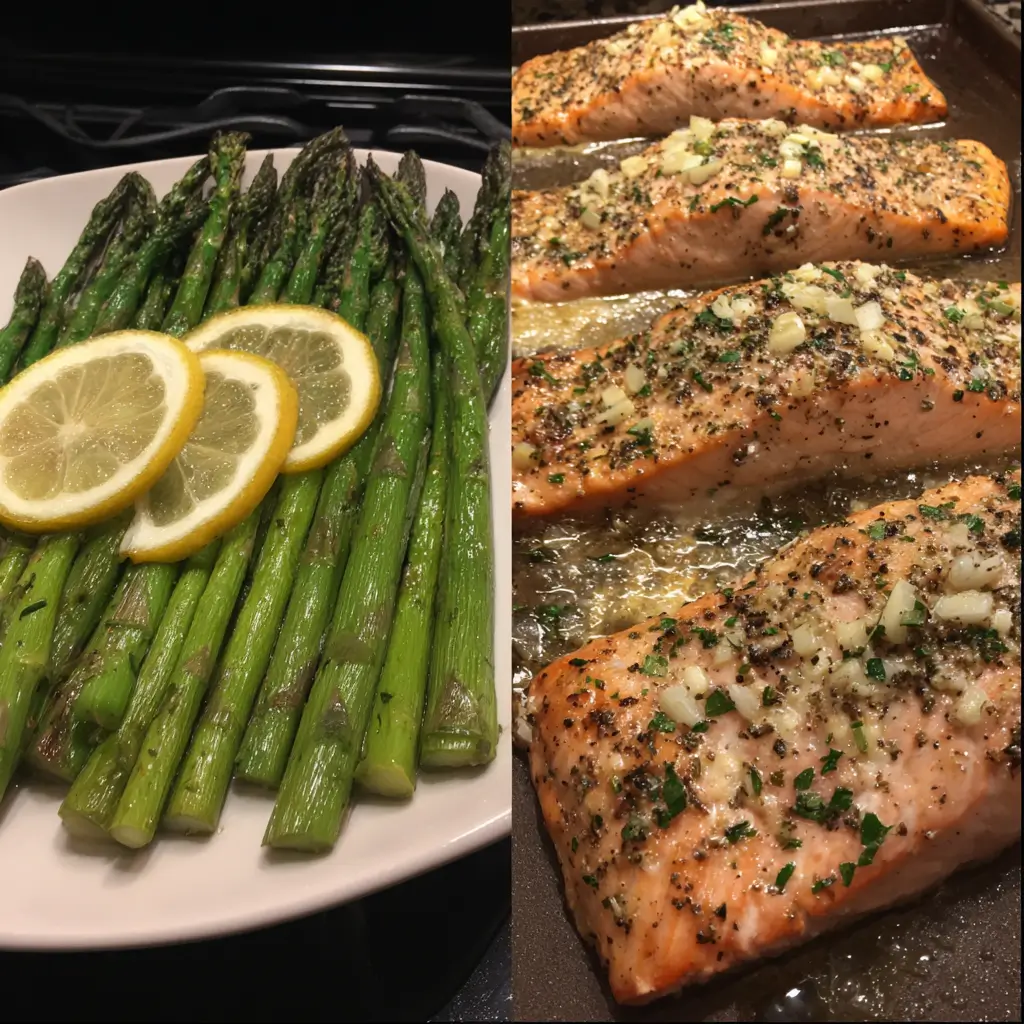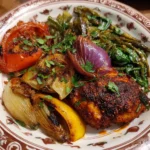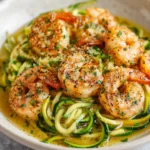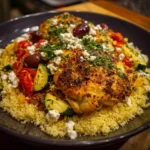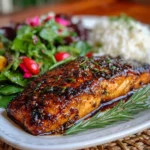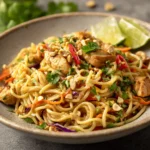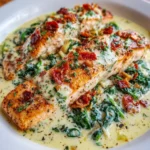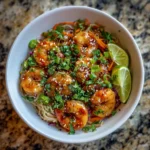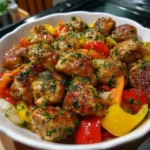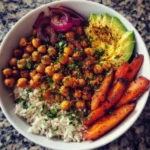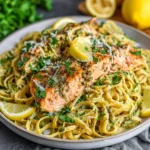Garlic Herb Roasted Salmon and Asparagus: A Flavorful, Healthy Delight
There’s something truly magical about the combination of tender salmon and crisp asparagus roasted to perfection with aromatic garlic and fresh herbs. This dish is not only a feast for the taste buds but also a powerhouse of nutrition that brings elegance to any dinner table—whether it’s a weeknight family meal or a special weekend gathering. Easy to prepare, rich in flavor, and packed with essential nutrients, Garlic Herb Roasted Salmon and Asparagus is one of those recipes you’ll want to make on repeat.
The History Behind the Dish
Roasting fish with vegetables has deep roots in Mediterranean cuisine, where simplicity, freshness, and seasonality are celebrated. Countries like Greece, Italy, and Spain have long prepared meals that feature olive oil-roasted seafood alongside seasonal vegetables such as asparagus, zucchini, and tomatoes. The use of garlic and herbs like rosemary, thyme, and parsley dates back centuries, both for their flavor-enhancing qualities and their natural preservative and health-promoting properties.
Salmon, originally abundant in the cold rivers of the North Atlantic and Pacific, became widely popular in European and American diets in the 20th century, especially after the rise of sustainable aquaculture. Asparagus, known since ancient Roman times for its delicate flavor and diuretic properties, complements oily fish like salmon beautifully due to its slight bitterness and firm texture when roasted.
The modern iteration of Garlic Herb Roasted Salmon and Asparagus emerged as part of the clean-eating and farm-to-table movements, which emphasize whole, unprocessed ingredients cooked simply to highlight their natural goodness. Today, this dish is a staple in health-conscious kitchens around the world, praised for its balance of protein, healthy fats, fiber, and antioxidants.
Ingredients Breakdown
Each ingredient in this recipe plays a vital role in building layers of flavor, texture, and nutritional value:
- Salmon Fillets: Rich in omega-3 fatty acids, high-quality protein, vitamin D, and selenium, wild-caught or sustainably farmed salmon offers a buttery texture and robust flavor that stands up well to roasting.
- Asparagus: Packed with fiber, vitamins K, C, and A, and folate, asparagus adds color, crunch, and earthiness. When roasted, its natural sugars caramelize slightly, enhancing sweetness.
- Garlic: More than just a flavor booster, garlic contains allicin, a compound with anti-inflammatory and immune-supporting properties. Freshly minced garlic infuses the oil and coats the ingredients evenly.
- Fresh Herbs (Parsley, Thyme, Rosemary): These herbs contribute brightness and complexity. Parsley adds freshness, thyme brings subtle floral notes, and rosemary imparts a pine-like aroma that pairs perfectly with salmon.
- Olive Oil: A cornerstone of the Mediterranean diet, extra virgin olive oil provides heart-healthy monounsaturated fats and helps crisp the salmon skin while preventing sticking.
- Lemon: Lemon juice and zest cut through the richness of the salmon, adding acidity and vibrancy. They also enhance the absorption of certain nutrients.
- Salt and Black Pepper: Essential seasonings that elevate all other flavors without overpowering them.
- Optional Additions: Red pepper flakes for heat, capers for brininess, or Dijon mustard for depth in the marinade.
Step-by-Step Recipe
- Preheat the Oven: Set your oven to 400°F (200°C). This temperature ensures even cooking—crispy edges on the salmon while keeping the inside moist.
- Prepare the Baking Sheet: Line a large rimmed baking sheet with parchment paper or lightly grease it with olive oil to prevent sticking. A non-stick surface makes cleanup effortless.
- Trim and Wash Asparagus: Snap off the woody ends of the asparagus by bending each spear until it breaks naturally. Rinse under cold water and pat dry thoroughly.
- Toss Asparagus with Seasonings: In a large bowl, combine asparagus with 2 tablespoons of olive oil, 2 minced garlic cloves, salt, pepper, and half of the chopped thyme and rosemary. Toss until evenly coated.
- Arrange on Tray: Spread the seasoned asparagus in a single layer on the prepared baking sheet. Try not to overcrowd; this allows proper air circulation for roasting rather than steaming.
- Season the Salmon: Pat salmon fillets dry with paper towels (this helps achieve a better sear). Place them skin-side down on top of or beside the asparagus. Drizzle with 1 tablespoon of olive oil.
- Create the Garlic-Herb Mixture: In a small bowl, mix 3 minced garlic cloves, 1 tablespoon lemon juice, 1 teaspoon lemon zest, remaining herbs, salt, and pepper. Optionally add ½ teaspoon Dijon mustard for creaminess and tang.
- Coat the Salmon: Spoon or brush the garlic-herb mixture evenly over the top of each salmon fillet, making sure to cover the surface completely.
- Roast: Place the tray in the preheated oven and roast for 12–15 minutes, depending on the thickness of the salmon. The salmon is done when it flakes easily with a fork and reaches an internal temperature of 145°F (63°C).
- Optional Broil: For a golden-brown finish, switch the oven to broil for the last 1–2 minutes, watching closely to avoid burning.
- Garnish and Serve: Remove from the oven and let rest for 2–3 minutes. Squeeze fresh lemon juice over everything and sprinkle with chopped parsley for a burst of color and freshness.
Tips for Perfect Results Every Time
- Choose Uniform Fillets: Select salmon fillets of similar size and thickness so they cook evenly.
- Dry the Salmon First: Moisture is the enemy of browning. Always pat the salmon dry before seasoning.
- Don’t Overcrowd the Pan: Give space between fillets and asparagus to ensure roasting, not steaming.
- Use Fresh Garlic: Pre-minced jarred garlic lacks the punch and freshness needed for optimal flavor.
- Add Lemon at the End: While some lemon goes into the marinade, finishing with a squeeze of fresh juice right before serving brightens the entire dish.
- Check Doneness Early: Salmon continues to cook slightly after removal from the oven (carryover cooking), so pulling it out just before it’s fully done yields perfect results.
- Save the Juices: The flavorful juices and oils left on the pan can be drizzled over the plated dish for extra richness.
- Use a Fish Spatula: Its thin, flexible edge makes lifting delicate salmon fillets without breaking them much easier.
Variations and Customizations
This recipe is incredibly versatile and can be adapted to suit different tastes, dietary needs, and seasonal ingredients:
- Gluten-Free & Keto-Friendly: Naturally gluten-free and low-carb, this dish fits seamlessly into ketogenic, paleo, and Whole30 diets.
- Dairy-Free Option: No dairy is used, making it ideal for those avoiding lactose or casein.
- Vegetable Swaps: Substitute asparagus with green beans, broccoli, Brussels sprouts, zucchini, or cherry tomatoes. Mix and match for variety.
- Herb Variations: Try dill and tarragon for a Scandinavian twist, or cilantro and lime for a more Latin-inspired flavor profile.
- Spicy Kick: Add red pepper flakes, sliced jalapeño, or a dash of smoked paprika to the herb mix for heat.
- Citrus Alternatives: Orange, grapefruit, or yuzu can replace lemon for a unique citrus note.
- Marinated Version: Marinate the salmon for 30 minutes to 2 hours in the garlic-herb mixture for deeper flavor penetration.
- Whole Tray Bake: Turn this into a complete sheet pan dinner by adding baby potatoes or sweet potatoes (roast them for 15 minutes before adding salmon and asparagus).
- Asian-Inspired Twist: Replace herbs with ginger, soy sauce (or tamari), sesame oil, and scallions. Garnish with toasted sesame seeds.
- Caper-Lemon Butter Finish: After roasting, melt a knob of butter with capers and lemon juice and spoon over the salmon for a restaurant-style upgrade.
Health Considerations and Nutritional Value
Garlic Herb Roasted Salmon and Asparagus isn’t just delicious—it’s a nutritionally balanced meal that supports overall wellness:
- Omega-3 Fatty Acids: Found abundantly in salmon, these essential fats reduce inflammation, support brain function, and promote heart health.
- Lean Protein: Salmon provides approximately 22–25 grams of high-quality protein per 4-ounce serving, aiding muscle repair and satiety.
- Fiber and Digestive Health: Asparagus contains inulin, a prebiotic fiber that feeds beneficial gut bacteria, supporting digestive balance.
- Antioxidants: Garlic, lemon, and herbs are rich in antioxidants like vitamin C, flavonoids, and polyphenols, which combat oxidative stress.
- B-Vitamins: Salmon is an excellent source of B12, niacin, and B6, crucial for energy metabolism and nervous system function.
- Vitamin K and Blood Health: Asparagus delivers nearly half the daily recommended intake of vitamin K per cup, important for blood clotting and bone health.
- Low Glycemic Index: With minimal carbohydrates and no added sugar, this dish is suitable for diabetics and those managing insulin levels.
- Heart-Healthy Fats: Olive oil contributes monounsaturated fats linked to reduced LDL cholesterol and improved cardiovascular outcomes.
Nutrition Estimate (per serving, based on 4 servings):
- Calories: ~380 kcal
- Protein: 32g
- Fat: 25g (mostly unsaturated)
- Carbohydrates: 8g
- Fiber: 4g
- Sugar: 3g (naturally occurring)
- Sodium: 380mg (adjustable based on added salt)
Ingredients
- 4 (6 oz) salmon fillets, skin-on or skinless
- 1 lb fresh asparagus, trimmed
- 3 tbsp extra virgin olive oil, divided
- 5 cloves garlic, minced (divided)
- Zest and juice of 1 lemon (divided)
- 1 tbsp fresh thyme leaves (or 1 tsp dried)
- 1 tbsp fresh rosemary, finely chopped (or 1 tsp dried)
- 2 tbsp fresh parsley, chopped (plus extra for garnish)
- ½ tsp sea salt (or to taste)
- ¼ tsp freshly ground black pepper
- Optional: ¼ tsp red pepper flakes, 1 tsp Dijon mustard, 1 tbsp capers
Directions
- Preheat oven to 400°F (200°C). Line a large baking sheet with parchment paper.
- In a large bowl, toss asparagus with 2 tablespoons olive oil, 2 cloves minced garlic, ½ teaspoon salt, ¼ teaspoon pepper, and half the thyme and rosemary. Spread evenly on the baking sheet.
- In a small bowl, combine 1 tablespoon olive oil, remaining 3 cloves minced garlic, juice and zest of half the lemon, remaining herbs, and optional Dijon mustard. Mix into a paste.
- Pat salmon fillets dry and place on the baking sheet over or next to asparagus. Season lightly with salt and pepper.
- Spread the garlic-herb mixture evenly over the top of each salmon fillet.
- Rose for 12–15 minutes, until salmon is opaque and flakes easily with a fork.
- Remove from oven and let rest for 2–3 minutes. Squeeze remaining lemon half over the dish and sprinkle with fresh parsley.
- Serve immediately, optionally with additional lemon wedges on the side.
FAQ
Can I use frozen salmon?
Yes, but thaw it completely in the refrigerator overnight before cooking. Frozen salmon may release more moisture, so pat it very dry before seasoning.
Is it safe to eat salmon medium-rare?
Yes, many chefs prefer salmon slightly pink in the center. Ensure it reaches at least 120°F (49°C) for medium-rare and comes from a reputable source. For food safety, the FDA recommends 145°F (63°C).
Can I roast the salmon and asparagus at different temperatures?
Not necessary—their roasting times align well at 400°F. If using thicker vegetables, start them earlier.
How do I store leftovers?
Store cooled leftovers in an airtight container for up to 2 days. Reheat gently in the oven or enjoy cold in salads.
Can I cook this in a convection oven?
Absolutely! Convection promotes even browning. Reduce temperature by 25°F or shorten cooking time by 2–3 minutes.
What sides pair well with this dish?
Quinoa, brown rice, couscous, roasted potatoes, or a simple arugula salad with vinaigrette complement the flavors beautifully.
Is asparagus always in season?
Peak season is spring (March to June), but it’s widely available year-round due to global farming. Look for firm, bright green stalks with tight tips.
Can I grill instead of roast?
Yes! Grill salmon on a well-oiled griddle or in a foil packet. Grill asparagus directly over medium heat, turning occasionally.
Summary
Garlic Herb Roasted Salmon and Asparagus is a nutritious, elegant, and easy-to-make meal that brings together bold flavors and wholesome ingredients in perfect harmony. Ideal for busy weeknights or impressive enough for guests, this dish proves that healthy eating can be absolutely delicious.
